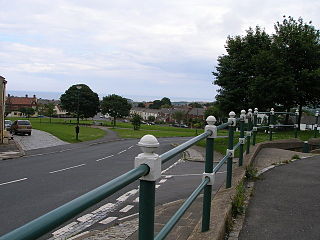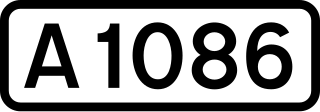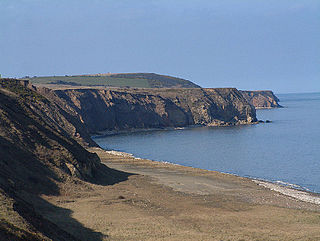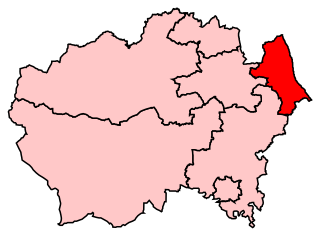
Seaham is a seaside town in County Durham, England. Located on the Durham Coast, Seaham is situated 6 miles south of Sunderland and 13 miles (21 km) east of Durham. The town grew from the late 19th century onwards as a result of investments in its harbour and coal mines. The town is twinned with the German town of Gerlingen.

Peterlee is a town in County Durham, England. It lies between Sunderland to the north, Hartlepool to the south, the Durham Coast to the east and Durham to the west. It gained town status in 1948 under the New Towns Act 1946. The act also created the nearby settlement of Newton Aycliffe and later Washington, Tyne and Wear.

Easington, also known as Easington Village, is a village and civil parish in eastern County Durham, England. It is located at the junction of the A182 and B1283, leading north-west to Hetton-le-Hole and south east to Horden.

Easington was, from 1974 to 2009, a local government district in eastern County Durham, England. It contained the settlements of Easington, Seaham, Peterlee, Murton, Horden, Blackhall, Wingate and Castle Eden. It did not however include Easington Lane which is administered as part of the City of Sunderland.

Easington Lane is a village in the City of Sunderland metropolitan borough in the county of Tyne and Wear, North East England. Historically part of County Durham and located between Hetton-le-Hole, Seaham, Peterlee and Durham. It had a population of 4,044 at the 2001 Census, increasing to 7,193 at the 2011 Census.

The A1086 is a road in County Durham, north-east England.

Hesleden is a village in County Durham, England, south of Peterlee. The name is a combination of Dene and Hesle, which is from "hazel". The combined population of the five communities making up the parish of Monk Hesleden was 5,722 at the 2011 Census.

Blackhall Colliery is a village on the North Sea coast of County Durham, in England. It is situated on the A1086 between Horden and Hartlepool. To the south of the Blackhall Colliery's Catholic church is Blackhall Rocks.

Blackhall Rocks is a village on the North Sea coast of County Durham, North East England. It is situated on the A1086 between Horden and Hartlepool, and just south of Blackhall Colliery which it adjoins. It is sometimes referred to by locals in the area as "The Rocks".

Easington Colliery is a town in County Durham, England, known for a history of coal mining. It is situated to the north of Horden, a short distance to the east of Easington Village. The town suffered a significant mining accident on 29 May 1951, when an explosion in the mine resulted in the deaths of 83 men.

Shotton Colliery is a village in County Durham, England, situated north west of Peterlee.
Monk Hesleden is a village and civil parish in County Durham, England. The population of the parish at the 2011 Census was 5,722. The parish is situated to the north-west of Hartlepool, and is on the North Sea coast. Monk Hesleden village is situated a short distance to the south of High Hesleden.

The Durham Coast Line is an approximately 39.5-mile (63.6 km) railway line running between Newcastle and Middlesbrough in North East England. Heavy rail passenger services, predominantly operated Northern Trains, and some freight services operate over the whole length of the line; it provides an important diversionary route at times when the East Coast Main Line is closed. Light rail services of the Tyne and Wear Metro's Green Line also operate over the same tracks between a junction just south of Sunderland station and Pelaw Junction.

Easington is a constituency created in 1950 represented in the House of Commons of the UK Parliament since 2010 by Grahame Morris of the Labour Party.

Horden is a railway station on the Durham Coast Line, which runs between Newcastle and Middlesbrough via Hartlepool. The station, situated 10 miles 74 chains (17.6 km) south-east of Sunderland, serves the villages of Horden, Blackhall Colliery and Easington along with the town of Peterlee in County Durham, North East England. It is owned by Network Rail and managed by Northern Trains.

Easington railway station served the town of Easington Colliery and Easington Village in County Durham, North East England. It was located on the Durham Coast Line between the stations at Horden and Seaham.

Shotton Bridge railway station was a railway station built by the North Eastern Railway (NER) on the route of the Hartlepool Dock & Railway (HD&R) as part of a programme of works to modernise that line and link it with the Durham & Sunderland Railway (D&SR) so as to create a railway through-route between West Hartlepool and Sunderland. On opening, the station served the relatively new village of Shotton Colliery, which grew around the nearby Shotton Grange Colliery, as well as Old Shotton on the Stockton to Sunderland turnpike road, further to the east.




















